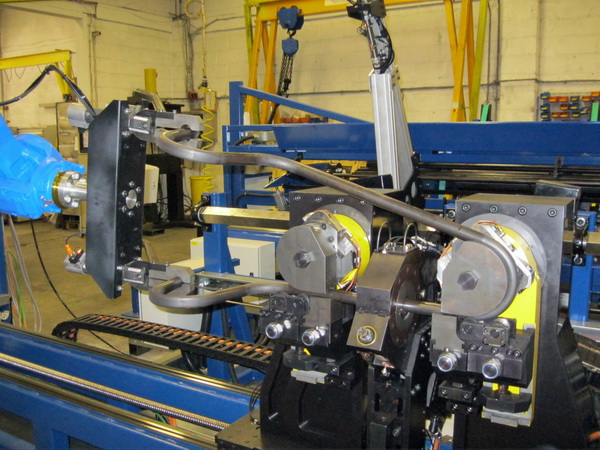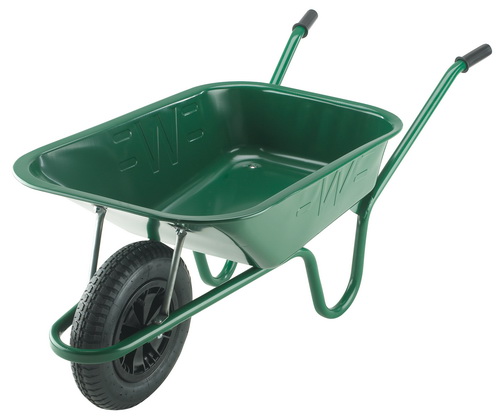|
Fully-automated production cell increases wheelbarrow frame manufacturing efficiency
4/5/2012 |
|
|
all-electric tube bending cell does the work of more than three bending and punching machines
April 3, 2012 --- A new fully-automated production cell for wheelbarrow frames is enabling Walsall Wheelbarrow Company to improve manufacturing efficiency significantly. Designed and produced by Unison, the cell has just been commissioned at Walsall Wheelbarrow's manufacturing plant in Wolverhampton, and following operator training is already running at about 90% capacity.
Walsall Wheelbarrow Company is one of the UK's leading manufacturers of wheelbarrows for gardening, building and agriculture. According to Jonathan Thacker, Operations Director, "Our manufacturing process has five main stages: pan pressing, welding, tube bending, powder coating and assembly. Until now, we have only used hydraulically-powered CNC machines for bending the tubular wheelbarrow frames. However, due to significant business expansion, tube bending operations were becoming a production bottleneck. Consequently, we budgeted for a major automation upgrade to improve efficiency and throughput."
Walsall Wheelbarrow selected an all-electric tube bender from Unison - which forms the heart of the new production cell - primarily on the grounds of the machine's speed, energy efficiency and its ability to create very high quality bends thanks to better process control. All-electric tube bending machines have become very popular with companies seeking to reduce manufacturing costs, because they only consume significant energy during the bending operation itself, making them an order of magnitude more efficient than traditional hydraulically-powered machines. Walsall Wheelbarrow also judged that it would benefit from more responsive technical support if it purchased directly from a domestic company.
The production cell operates completely automatically, and is centred around a five-axis twin-head Unison bending machine. These types of bending machines are ideal for applications where component parts have a high degree of symmetry, such as supermarket shopping trolleys, luggage carriers and tubular bases for vehicle seats. Having tracked the progress of Unison's twin-head machines ever since they were first developed, Walsall Wheelbarrow was in no doubt that this configuration was ideal for accelerating the production of frames.
The automated production cell comprises a tube bundle loader, multifunction processing station, intermediate dual-arm loader, bending machine and an articulated robotic handler. All these stages are controlled by a central PC. As soon as the bundle loader's hopper is filled and the operating program is selected, the cell operates completely automatically. The bundle loader feeds tubes individually to the multifunction station, which performs weld seam detection, tube orientation and centralising, and all-electric hole punching. The tube is then transferred to the bending machine by the dual-arm loader, and after being bent to shape is removed by the robotic handler and placed in a multiple rack storage scheme.
The material used for the wheelbarrow frame depends on the model being manufactured, but typically consists of 28.5 mm diameter steel tubing with a wall thickness of 1.5 mm. The cell's strap bundle loader can handle tubes up to 3.8 metres in length and accommodates up to 500 tubes at a time. Walsall Wheelbarrow currently loads the machine three times a day during the course of a standard 8-hour shift, producing around 1300 wheelbarrow frames in that period. Previously, the company used three hydraulic tube benders to achieve its daily production quota.
Jonathan Thacker points out that the Unison production cell provides a very flexible manufacturing capability: "The fully automated nature of the cell means that we can now handle extended production runs much more efficiently. Furthermore, with the hydraulic benders, holes have to be punched at a separate machine station. The new Unison production cell handles both hole punching and bending and these functions take place simultaneously. While one frame is being bent, another is being punched. This overlap decreases machine cycle time and accelerates throughput - we can bend more than two frames a minute. Each of the three hydraulic tube benders we were using had an output of around 500 frames per day. Thanks to twin head bending, and automated loading, the new cell can produce 1300 in the same timeframe and punch holes as well. We have kept one of the old machines in service, which together with the new cell increases our production capacity to 1800 frames per day, with the other two hydraulic machines still available to help with any peak demand situations."
Product changeover is very straightforward. Walsall Wheelbarrow is using the cell to produce all the frames for its Easyload, Integral and Contractor wheelbarrow models, which account for about 80% of its total production. Two of these models use 3.6 metre frames and the all-electric cell can be switched from manufacturing one type to the other in around 2 minutes. The third model has a 3.8 metre frame so changeover involves more tooling adjustments and takes slightly longer; nevertheless, the company has already got this down to 15 minutes after only a short period of use.
The multifunction station's weld seam detection system works by evaluating the magnetic flux density of the tube as it is rotated, which provides a reliable method of correctly orienting the tube prior to further processing. A key advantage of this approach is that it is impervious to the prevailing light conditions, which can affect the accuracy of automated vision systems. Accurately orienting the tube is important for several reasons: it prevents holes being punched through the weld seam and helps ensure process consistency, because the seam affects the spring-back characteristics of the tube during bending. If a tube fails the weld seam detection test it is rejected automatically and moved to an area where it can subsequently be examined by the operator; this helps maximise system throughput by preventing potentially faulty parts being processed.
As well as performing a tube centralising function to ensure symmetrical accuracy of the wheelbarrow frame, the multifunction station includes the latest revision of Unison's all-electric hole punching system, which provides a highly cost-effective alternative to conventional hydraulic punches. The system punches holes through both sides of the tube to accept the fixing bolts needed for wheelbarrow assembly, typically making four pairs of holes. After hole punching, the station's integrated dual-arm loader transfers the tube to the bending machine while maintaining its seam orientation.
Based on two electric servomotor-driven bending heads, the five-axis Unison tube bending machine features two servomotor-driven linear carriages, together with a clamp and rotation unit located between the heads. The two bending heads operate simultaneously, reducing the machine's cycle time significantly. The number of tube bends depends on the particular wheelbarrow model, but typically consists of four per frame side, plus a centre bend to form the main loop around the wheelbarrow's wheel.
As soon as the bending process is complete, an articulated handling robot offloads the frame and places it in a mobile multiple rack store, ready for the next manufacturing stage. The robot forms an integral part of the production cell.
Jonathan Thacker is confident that the production cell will generate significant cost savings, "The Unison cell is effectively handling almost the same volume as three hydraulic bending machines, and for a much lower energy consumption as well. This, together with the fact that it also punches holes, has enabled us to redeploy staff and speed the development of several new products. What's more, the reliability of the production cell has improved process flow, helping to reduce work peaks and backlogs in the welding and powder coating stages of manufacture."
"Automated tube fabrication cells can significantly enhance productivity and flexibility," adds Unison's Alan Pickering. "As well as demonstrating the speed advantages of twin-head bending for fabricating symmetrical parts, Walsall Wheelbarrow's application shows how the introduction of this type of integrated automation provides companies with the opportunity to re-evaluate their production processes. In this instance, concurrent hole punching and bending further increases throughput, improves workflow and completely eliminates a number of manually-intensive operations and their associated materials handling tasks. Many other fabrication companies could benefit from taking a similarly fresh look at how automation can help them improve process efficiency."
|
|
|
|
|
|







